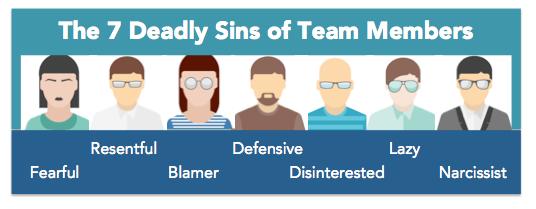
Originally posted on https://www.workboard.com/blog/dynamics-of-low-performing-teams.php
High performing teams seem to generate their own energy and elevate everyone on the team to their full potential. Despite achieving more, work on these teams seems less taxing, the workday shorter and less frustrating. (Part 1 of this article looks at the Six Hallmarks of High-Performing Teams.) In contrast, low performing teams are plagued by dysfunction and produce more frustration than progress.
What undermines the performance of groups and teams? Poor leadership and low self awareness from team members.
The Leader’s Role in Dysfunction
The most common leadership failure points are the hardest part of a leaders’ job: getting the wrong people off the team, holding people accountable and giving direct feedback. These aspects of management and leadership push us into uncomfortable territory. Sometimes managers don’t have support resources or skills in these areas and in large organizations, there may appear to be a high social price as well.
Building and exercising management skills are essential because great performers will leave the team for better places to work and the rest of the team will disengage (as more than 70% of employees have!) — the doomsday cycle for teams, companies and careers. The five dynamics of low performing teams stem from what leaders don’t do and the vacuum from what is missing:
1. Freeloaders
Teams with freeloaders consistently under perform. About 2 in 10 employees are actively disengaged in their work and undermine value created by their peers, according to Gallup. Less destructive freeloaders benefit from the results of the group but contribute nothing to it, demotivating their peers. While it’s one of the least pleasant aspects of management, avoidance compounds rather than corrects the problem.
2. Vague Goals
Without clear goals and objective or, worse, with a goal de jour, there is little chance of great achievement. because great performers will leave the team for better places to work and the rest of the team will disengage (as more than 70% of employees have! When team members don’t know what they’re working toward, the resulting vacuum of purpose is unsatisfying at best and chaotic at worst. The absence of progress on a meaningful goal devalues and frustrates team members. This goal kit can help establish goals and rally the team toward their achievement.
3. No Transparency
Without discipline and systems of transparency, the team wastes its time and effort trying to figure where it is and where it’s going — mind-numbing status meetings and cadence calls are the result. Everyone feels busy, but nothing important gets accomplished. Develop a transparency discipline so goals and actions to achieve them are visible. This is the substrate of achievement and accountability.
4. No Accountability
Half of all managers are “terrible” at driving accountability, according to Harvard Business Review. Fear of being the bad guy and lack of discipline hold people back. Without accountability, mediocrity rules and careers suffer. Not holding people accountable for under performing does them no favors, misleading them or implicitly validating their performance — until review time surprises. On the best teams, members hold themselves and each other accountable. Engage your team in defining a shared accountability standard and use committed actions week over week to sustain it.
5. Feedback Fear
No feedback is actually worse than negative feedback — team members want it, managers hesitate to provide it! Get over the discomfort and make it a habit to provide regular feedback. Young people do 70% of their learning on the job so positive reinforcement is most effective (and among managers’ highest priorities). Experts with mature skills benefit most from constructive feedback to advance those skills. In fact, 57% of employees say constructive critique and feedback helps them improve; a 5:1 ratio of positive to negative works best.
The Individuals’ Role in Dysfunction
It is easy and tempting for team members to blame team dysfunction on leaders’ failure to lead. Not so fast: Teams are a collection of people who can choose to work well together — or not. Each person contributes to the chemistry and function of the team, and everyone is responsible for their own contribution. I’ve found it even more important to raise my self awareness on lower performing teams. In the same way great teams elevate everyone’s performance, dysfunctional teams tend to degrade each individual’s performance.

Doing a gut check on the deadly sins helps me align my actions with my unwavering intentions for great performance. And I will confess that fear and defensiveness are my sins when I’m not at my best or when I’m reacting rather than acting with awareness! When I take responsibility for those I not only feel better, I perform better and help elevate others.
How have you turned around a team? When the team isn’t working well, does your engagement degrade too? What personal tactics do you use to re-balance?
If you’re interested in the “highs” of high performing teams, see The 6 Hallmarks of High Performing Teams (part 1 of this post). My next post will be about the role of compassion and empathy at work.